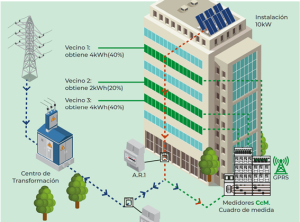Shared Self-consumption is one of the most interesting energy models. It offers great economic and energy savings by allowing several consumers to share the same photovoltaic installation. It is therefore open to blocks of apartments, industrial estates and energy communities.
It involves the installation of solar panels on the roof of a building or industrial building, and provides photovoltaic electricity supply to neighbors or adjacent buildings.
Both the installation and the self-consumers must be in the same cadastral reference. In the case of warehouses or businesses, they must be at a maximum of 500 meters from the production center, and share at least 14 cadastral digits.
It is necessary to reach an agreement between at least one third of the owners of the houses or buildings through a legal form (community of owners, energy communities, etc.).
There are two modalities, being the public network modality the one we will see in depth:
- Public grid: This is the most common. The photovoltaic plant connects to the low voltage grid by means of a bidirectional meter, therefore, the distributor and the marketer compensate the self-consumers through this public grid.
- Inland Grid: The photovoltaic production is distributed directly to each of the self-consumers’ inland grids.
Currently, the distribution system is based on static coefficients that can be modified periodically (annually). These coefficients can be calculated according to their consumption or to a quota fixed in advance. The installation is made on the roof of the building, and each neighbor participates in a coefficient that is calculated in advance.

The electrical flow goes to the entrance or electrical connection of the building, and is compensated with each neighbor according to the predefined coefficient.
When the installation is finished, we are in charge of communicating to Industry and the distribution company the participation coefficient of each neighbor. These organizations are in charge of communicating this participation to the commercialization companies so that they can charge the energy compensation to each neighbor.
This compensation is based on consumption and the distributor is obliged to do so.
If we assume a self-production of 100 kWh in a community of 5 neighbors, at the end of the month, the supplier has to compensate 20 kWh to each neighbor, so that if a neighbor has consumed 60 kWh, minus 20 kWh (100/5) of compensation, only 40 kWh would be paid for. The supplier is obliged to compensate in the same time period that the self-consumption takes place.
If you want more information about collective self-consumption and do not know where to start, Bettergy can help you, offering you a suite of tools to analyze projects in a simple and intuitive way with a high degree of customization.
Tools that we are continuously improving with new technologies to provide greater security and confidence to participants, for example, with our project for the digitization of the management, operation and maintenance processes of renewable distributed generation assets [1].







